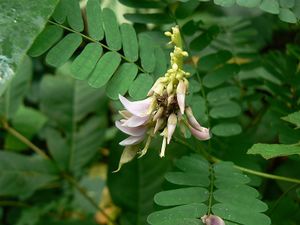Note: This is a project under development. The articles on this wiki are just being initiated and broadly incomplete. You can Help creating new pages.
Difference between revisions of "Anemone obtusiloba"
| (3 intermediate revisions by the same user not shown) | |||
| Line 1: | Line 1: | ||
| − | + | [[File:Abrus precatorius (1463017430).jpg|thumb|right|''Abrus precatorius'', '' Gunjaa'']] | |
| − | + | '''Anemone obtusiloba''' is a perennial herb which is very variable, with 2-5 cm buttercup flowers in colors white, blue or yellow. | |
==Uses== | ==Uses== | ||
| − | {{Uses|}}, {{Uses|}}, {{Uses|}}, {{Uses| | + | {{Uses|Contusions}}, {{Uses|Blistering agent}}, {{Uses|Vomiting}}, {{Uses|Rheumatism}}. |
==Parts Used== | ==Parts Used== | ||
| − | {{Parts Used| | + | {{Parts Used|Leaves}}. |
==Chemical Composition== | ==Chemical Composition== | ||
| Line 17: | Line 17: | ||
===Dravya=== | ===Dravya=== | ||
===Rasa=== | ===Rasa=== | ||
| − | |||
===Guna=== | ===Guna=== | ||
| Line 30: | Line 29: | ||
==Habit== | ==Habit== | ||
| − | {{Habit|}} | + | {{Habit|Perennial}} |
==Identification== | ==Identification== | ||
| Line 49: | Line 48: | ||
==Mode of Propagation== | ==Mode of Propagation== | ||
| − | {{Propagation|}} | + | {{Propagation|Seeds}} |
==How to plant/cultivate== | ==How to plant/cultivate== | ||
| − | <ref name="How to plant/cultivate"/> | + | Succeeds in ordinary garden soil but prefers a rich sandy loam[1]. Requires a well-drained humus-rich soil in full sun[200]. Requires a warm sheltered position.<ref name="How to plant/cultivate"/> |
==Commonly seen growing in areas== | ==Commonly seen growing in areas== | ||
| − | {{Commonly seen|}} | + | {{Commonly seen|Moist open slopes}} |
==Photo Gallery== | ==Photo Gallery== | ||
<gallery class="left" caption="" widths="140px" heights="140px"> | <gallery class="left" caption="" widths="140px" heights="140px"> | ||
| − | + | Anemone obtusiloba 'Pradesh' (8999892687).jpg | |
| + | Anemone obtusiloba (2562162846).jpg | ||
| + | Blaue Himalaya-Anemone (Anemone obtusiloba) 5668.JPG | ||
| + | Edwards' botanical register, or, Ornamental flower-garden and shrubbery .. (1829-1847) (20552753824).jpg | ||
</gallery> | </gallery> | ||
==References== | ==References== | ||
| − | |||
<references> | <references> | ||
<ref name="chemical composition">["chemistry"]</ref> | <ref name="chemical composition">["chemistry"]</ref> | ||
| − | |||
<ref name="Leaf">["morphology"]</ref> | <ref name="Leaf">["morphology"]</ref> | ||
| − | + | <ref name="How to plant/cultivate">[https://pfaf.org/user/Plant.aspx?LatinName=Anemone+obtusiloba Cultivation]</ref> | |
| − | <ref name="How to plant/cultivate">[ | ||
</references> | </references> | ||
==External Links== | ==External Links== | ||
| − | * [ ] | + | * [http://www.flowersofindia.net/catalog/slides/Himalayan%20Thimbleweed.html ] |
| − | * [ ] | + | * [http://temperate.theferns.info/plant/Anemone+obtusiloba ] |
| − | + | ||
[[Category:Herbs]] | [[Category:Herbs]] | ||
[[Category:Pages without herbs images]] | [[Category:Pages without herbs images]] | ||
Latest revision as of 17:03, 24 March 2020
Anemone obtusiloba is a perennial herb which is very variable, with 2-5 cm buttercup flowers in colors white, blue or yellow.
Contents
- 1 Uses
- 2 Parts Used
- 3 Chemical Composition
- 4 Common names
- 5 Properties
- 6 Habit
- 7 Identification
- 8 List of Ayurvedic medicine in which the herb is used
- 9 Where to get the saplings
- 10 Mode of Propagation
- 11 How to plant/cultivate
- 12 Commonly seen growing in areas
- 13 Photo Gallery
- 14 References
- 15 External Links
Uses
Contusions, Blistering agent, Vomiting, Rheumatism.
Parts Used
Chemical Composition
Common names
| Language | Common name |
|---|---|
| Kannada | |
| Hindi | |
| Malayalam | |
| Tamil | |
| Telugu | |
| Marathi | |
| Gujarathi | |
| Punjabi | |
| Kashmiri | |
| Sanskrit | |
| English |
Properties
Reference: Dravya - Substance, Rasa - Taste, Guna - Qualities, Veerya - Potency, Vipaka - Post-digesion effect, Karma - Pharmacological activity, Prabhava - Therepeutics.
Dravya
Rasa
Guna
Veerya
Vipaka
Karma
Prabhava
Habit
Identification
Leaf
| Kind | Shape | Feature |
|---|---|---|
Flower
| Type | Size | Color and composition | Stamen | More information |
|---|---|---|---|---|
| {{{5}}} |
Fruit
| Type | Size | Mass | Appearance | Seeds | More information |
|---|---|---|---|---|---|
Other features
List of Ayurvedic medicine in which the herb is used
Where to get the saplings
Mode of Propagation
How to plant/cultivate
Succeeds in ordinary garden soil but prefers a rich sandy loam[1]. Requires a well-drained humus-rich soil in full sun[200]. Requires a warm sheltered position.[3]
Commonly seen growing in areas
Photo Gallery
References
- ↑ ["chemistry"]
- ↑ ["morphology"]
- ↑ Cultivation
External Links
Categories:
- Ayurvedic Herbs known to be helpful to treat Contusions
- Ayurvedic Herbs known to be helpful to treat Blistering agent
- Ayurvedic Herbs known to be helpful to treat Vomiting
- Ayurvedic Herbs known to be helpful to treat Rheumatism
- Herbs with Leaves used in medicine
- Habit - Perennial
- Index of Plants which can be propagated by Seeds
- Herbs that are commonly seen in the region of Moist open slopes
- Herbs
- Pages without herbs images




